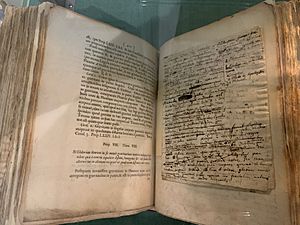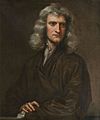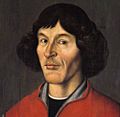Philosophiæ Naturalis Principia Mathematica facts for kids
The Philosophiæ Naturalis Principia Mathematica (which means Mathematical Principles of Natural Philosophy) is a very important set of three books. Isaac Newton wrote them, and they were published on July 5, 1687. These books changed how people understood the world.
The Principia explains key ideas in physics and mathematics. It introduces Newton's laws of motion, which describe how objects move. It also shows how Kepler's Laws of planetary motion can be understood using gravity.
Contents
What is the Principia About?
The Principia is divided into three main books. Each book focuses on different parts of how the universe works. Newton used mathematics to explain his ideas.
Book One: Motion of Objects
The first book is called De motu Corporum (On the Motion of Bodies). It talks about how objects move. Newton introduced his three famous laws of motion here. These laws explain things like why a ball stops rolling or why a rocket flies into space.
- First Law: An object at rest stays at rest, and an object in motion stays in motion with the same speed and in the same direction unless acted upon by an unbalanced force.
- Second Law: The acceleration of an object is directly related to the force applied to it and inversely related to its mass. This means a bigger push makes something speed up more.
- Third Law: For every action, there is an equal and opposite reaction. Think about pushing a wall; the wall pushes back on you.
Book Two: Motion in Resisting Media
The second book is called De motu Corporum, Liber Secundus (On the Motion of Bodies, Book Two). This part looks at how objects move when there is resistance. This could be like air resistance or water resistance. Newton studied how fluids (liquids and gases) affect moving objects.
Book Three: The System of the World
The third book is named De Systemate Mundi (On the System of the World). This is where Newton applied his laws to the entire universe. He showed how his law of universal gravity explains why planets orbit the Sun. He also explained Kepler's Laws of planetary motion.
- Kepler's Laws: These laws describe how planets move around the Sun. Newton proved that these laws are a natural result of his law of gravity.
- Universal Gravity: Newton proposed that every particle in the universe attracts every other particle. The strength of this attraction depends on their masses and the distance between them. This idea explained why apples fall from trees and why the Moon orbits Earth.
Why is the Principia Important?
The Principia is one of the most important books in the history of science. It laid the foundation for classical physics. It showed that the universe follows clear mathematical rules. This book helped scientists understand the natural world for centuries. It also inspired many future discoveries.
Images for kids
-
Sir Isaac Newton (1643–1727) author of the Principia
-
Newton's proof of Kepler's second law, as described in the book. If a continuous centripetal force (red arrow) is considered on the planet during its orbit, the area of the triangles defined by the path of the planet will be the same. This is true for any fixed time interval. When the interval tends to zero, the force can be considered instantaneous. (Click image for a detailed description).
-
Titlepage and frontispiece of the third edition, London, 1726 (John Rylands Library)
-
Nicolaus Copernicus (1473–1543) formulated a heliocentric (or Sun-centered) model of the universe
See also
 In Spanish: Philosophiæ naturalis principia mathematica para niños
In Spanish: Philosophiæ naturalis principia mathematica para niños









